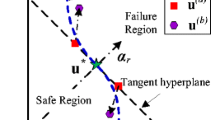Abstract
The weighted stochastic response surface method (WSRSM) has been demonstrated to be effective in improving the accuracy of the estimation of statistical moments and probability of failure (PoF) upon the stochastic response surface method (SRSM). However, it has been noticed that the weighting method in WSRSM may have little and sometimes negative impact on PoF estimation especially in the cases of low PoF. To mitigate this issue, a new double weighted SRSM (DWSRSM) is proposed that the weights of sample points are determined based on their importance not only to regression but also to PoF estimation. Specifically, relatively larger weights are assigned to points closer to the failure surface, which significantly accounts for the accuracy of PoF estimation. Comparative studies show that DWSRSM outperforms WSRSM producing more accurate PoF estimation without incurring additional function evaluations. An application of DWSRSM to the rocket design further demonstrates its effectiveness for PoF estimation.
Similar content being viewed by others
References
X. Du, A. Sudjianto and W. Chen, An integrated framework for optimization under uncertainty using inverse reliability strategy, ASME Journal of Mechanical Design, 126(4) (2004) 562–570.
Z. P. Mourelatos and J. Liang, A methodology for tradingoff performance and robustness under uncertainty, ASME Journal of Mechanical Design, 128(4) (2006) 856–863.
B. D Youn, K. K. Choi and K. Yi, Performance moment integration (PMI) method for quality assessment in reliability-based robust optimization, Mechanics Based Design of Structures and Machines, 33(2) (2005) 185–213.
J. Tu and K. K. Choi, A new study on reliability-based design optimization, ASME Journal of Mechanical Design, 121(4) (1999) 557–564.
M. Hohenbichler and Rackwitz, Improvement of secondorder reliability estimates by importance sampling, ASCE Journal of Engineering Mechanics, 114(12) (1988) 195–2199.
S. S. Isukapalli, A. Roy and P. G. Georgopoulos, Stochastic response surface methods (SRSMs) for uncertainty propagation: application to environmental and biological systems, Risk Analysis, 18(3) (1998) 351–363.
S. S. Isukapalli, Uncertainty analysis of transporttransformation models, Ph.D dissertation, The State University of New Jersey (1999).
S. S. Isukapalli, A. Roy and P. G. Georgopoulos, Efficient sensitivity/uncertainty analysis using the combined stochastic Response surface method and automated differentiation: application to environmental and biological systems, Risk Analysis, 20(5) (2000) 591–602.
X. Xiong, W. Chen, Y. Xiong and S. Yang, Weighted stochastic response surface method considering sample weights, Journal of Structural Multidisciplinary Optimization, 423(6) (2011) 837–849.
S. Rahman and D. Wei, A univariate approximation at most probable point for higher-order reliability analysis, International Journal of Solids and Structures, 43(9) (2006) 2820–2839.
F. Xiong, S. Greene, Y. Xiong, W. Chen and S. Yang, A new sparse grid based method for uncertainty propagation, Journal of Structural and Multidisciplinary Optimization, 41(3) (2010) 335–349.
H. P. Gavin and C. Y. Siu, High-order limit state functions in the response surface method for structural reliability analysis, Structural Safety, 30(2) (2006) 162–179.
I. Kaymaza and C. McMahon, A response surface method based on weighted regression for structural reliability analysis, Probabilistic Engineering Mechanics, 20(1) (2005) 11–17.
X. Nguyen, A. Sellier, F. Duprat and G. Pons, Adaptive response surface method based on a double weighted regression technique, Probabilistic Engineering Mechanics, 24(2) (2009) 135–143.
C. M. Creveling, Tolerance design: A handbook for developing optimal specifications, Addison-Wesley, MA (1997).
S. Kim and S. Na, Response surface method using vector projected sampling points, Structural Safety, 19(1) (1997) 3–19.
Author information
Authors and Affiliations
Corresponding author
Additional information
Recommended by Editor Maenghyo Cho
Fenfen Xiong is a faculty in School of Aerospace Engineering of Beijing Institute of Technology. Her research interests include multidisciplinary design optimization under uncertainty and flight vehicle design.
Rights and permissions
About this article
Cite this article
Xiong, F., Liu, Y., Xiong, Y. et al. A double weighted stochastic response surface method for reliability analysis. J Mech Sci Technol 26, 2573–2580 (2012). https://doi.org/10.1007/s12206-012-0425-4
Received:
Revised:
Accepted:
Published:
Issue Date:
DOI: https://doi.org/10.1007/s12206-012-0425-4



